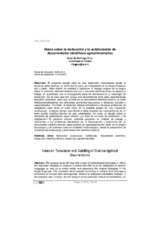Mostrar el registro sencillo del ítem
Notas sobre la traducción y la subtitulación de documentales científicos agroalimentarios
| dc.contributor.author | Ogea Pozo, María del Mar | |
| dc.date.accessioned | 2018-02-09T09:13:21Z | |
| dc.date.available | 2018-02-09T09:13:21Z | |
| dc.date.issued | 2013 | |
| dc.identifier.issn | 2255-3703 | |
| dc.identifier.uri | http://hdl.handle.net/10396/16118 | |
| dc.description.abstract | El presente trabajo trata de una traducción subordinada donde el traductor debe producir un texto escrito para ser interpretado en la lengua hablada, por lo tanto, debe dotarlo de oralidad y reproducir el diálogo original en la lengua meta. El traductor debe enfrentarse a la vez a una serie de limitaciones de espacio y tiempo en la pantalla, con la consiguiente toma de decisiones en la estrategia de traducción. En el caso que nos ocupa, nos encontramos ante unas características textuales peculiares, dado que se trata de un documental científico-técnico, un texto híbrido/multidisciplinar con diferentes elementos discursivos e idiolectos sociales y especializados. Por tanto, el traductor deberá enfrentarse a diversos problemas de adaptación para dotar el texto meta de la oralidad propia de una traducción audiovisual, al mismo tiempo que decide si debe respetar las características de un texto escrito científico-técnico de alta complejidad. Así pues, el debate sobre la disciplina de subtitulación sigue abierto: ¿se trata de un caso de traducción o de adaptación? El presente estudio pretende proponer un método de trabajo y soluciones a los problemas planteados en la transcripción y traducción de un documental científico-técnico especializado en agroalimentación, tanto en el ámbito tecnológico y de software como en el ámbito traductológico, desde la perspectiva de la traducción audiovisual y de la traducción científico-técnica. | es_ES |
| dc.description.abstract | The present study will deal with a type of subordinated translation in which the translator attempts to produce a written text that must be interpreted in spoken language, as well as to evoke orality and reproduce the original dialogues in the target language. The translator must operate according to several time and space limitations on screen, and consequently, choose an adequate translation strategy. In the present case of study, we will analyze some particular textual characteristics, as we will work on a technical and scientific documentary film: a hybrid and multidisciplinary text including different discursive elements, sociolects and specialized lexicon. The translator will take adaptation strategies in order to achieve orality in a target text which is a product of audiovisual translation, as well as translation strategies in order to produce a highly specialized technical and scientific written text. Thus, the debate on subtitling is still open: Is it a translation disciple or a type of adaptation? This study aims to propound a work strategy to face problems arisen during the transcription and translation of a science documentary specialized in agricultural and food technologies, regarding software and translation issues from the point of view of audiovisual translation and scientific and technical translation. | es_ES |
| dc.format.mimetype | application/pdf | es_ES |
| dc.language.iso | spa | es_ES |
| dc.publisher | UCOPress | es_ES |
| dc.rights | https://creativecommons.org/licenses/by/3.0/ | es_ES |
| dc.source | Skopos 2, 129-144 (2013) | es_ES |
| dc.subject | Traducción audiovisual | es_ES |
| dc.subject | Subtitulado | es_ES |
| dc.subject | Documental científico | es_ES |
| dc.subject | Traducción Científico-Técnica | es_ES |
| dc.subject | Traducción agroalimentaria | es_ES |
| dc.subject | Audiovisual translation | es_ES |
| dc.subject | Subtitling | es_ES |
| dc.subject | Science documentary | es_ES |
| dc.subject | Scientific-technical translation | es_ES |
| dc.subject | Agri-food translation | es_ES |
| dc.title | Notas sobre la traducción y la subtitulación de documentales científicos agroalimentarios | es_ES |
| dc.title.alternative | Notes on Translation and Subtitling of Science-Agrifood Documentaries | en |
| dc.type | info:eu-repo/semantics/article | es_ES |
| dc.relation.publisherversion | https://www.uco.es/ucopress/ojs/index.php/skopos/index | es_ES |
| dc.rights.accessRights | info:eu-repo/semantics/openAccess | es_ES |

